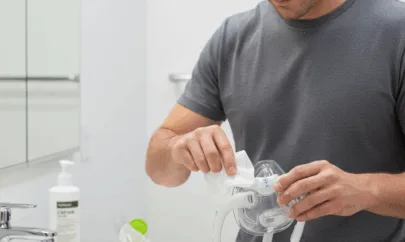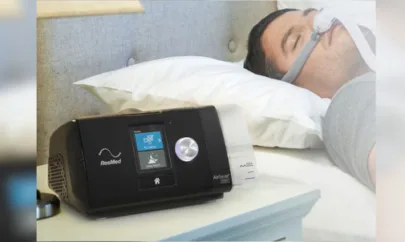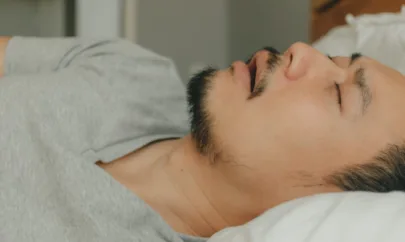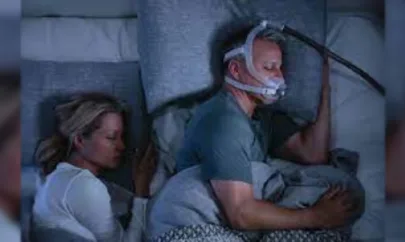
Comfortable Sleep Therapy: How to Prevent Nose Sores from APAP Mask
Automatic positive airway pressure (APAP) is a leading treatment for obstructive sleep apnea. The treatment involves delivering pressurized air through tubing to a mask worn while you sleep. This prevents the airways from collapsing.
However, it can take a little time for people to adjust to APAP.
A common APAP-related frustration is nose sores, which can often be the result of ill-fitting masks.
Finding the Right Mask is Key
Before discussing the signs of nose sores and how to prevent them, it is worth considering the three main types of masks.
- Full face – covers both the nose and the mouth and is a good option for mouth breathers and people who move a lot in the night. A new hybrid mask offers under the nose cushion and a seal for mouth breathers.
- Nasal – fits over the upper lip and bridge of the nose and is the most common, recommended for people who breathe through their nose
- Nasal pillow/cushion – consists of plastic prongs that fit into the nostrils and can be the better option for those who struggle with claustrophobia. An under-the-nose cushion is similar to a nasal pillow with less direct contact.
It may take several attempts to find the most suitable mask. Not only are there different types, they come in different sizes. Not everyone’s face shape and size are the same, so it is crucial to work with your health provider to find a mask that is comfortable and fits correctly to form a proper seal.
Signs of Nose Sores
Initially, you may experience sensitivity in or around the nose. Different masks can affect different areas. Full-face and nasal masks can irritate the bridge of the nose more, whereas the prongs of nasal pillow masks can affect the area just within the nostrils.
If you begin to feel sensitivity you should consult with your health provider. Prevention is always better than a cure. However, signs of nose sores include:
- An area is painful or tender to touch
- Redness in or around the nose
- Dry, cracked, or peeling skin
- Ulcers, blisters, or scabbing
- Nosebleeds in more severe instances
Nose sores are an irritant that can threaten continued compliance with your treatment for obstructive sleep apnea. Therefore, awareness of how to prevent sores is key.
How to Prevent Nose Sores from APAP Mask?
1. Correctly Fitting Masks
Ill-fitting masks can lead to issues that threaten compliance, including nose sores. As well as leaking air, masks that don’t fit to form a proper seal will rub against the skin. This friction may cause sores.
The straps on the headgear need to be tightened just enough to form a seal and prevent air leaks. Masks that are loose will also rub and cause sores. With full face and nasal masks, these sores are likely to develop on the bridge of the nose or just beneath the nostrils.
Sores can also develop within the nostrils from ill-fitting nasal pillow masks. You may need time for the skin inside the nose to thicken as it adapts to the prongs.
However, if the sores are a regular occurrence, you may be recommended to try different style masks or switching between nasal and nasal pillow masks to provide occasional respite for your nostrils.
My Suggestion: Masks now come with an under-the-nose cushion. These are offered by both ResMed and Philips – and patients like them because there is no nasal pillow that goes into the nostrils ResMed P30i and Dreamwear.
Instead, the under-the-nose cushion rests comfortably below the nose – and supplies the pressure directly into the nostrils, reducing the risk of nasal sores.
They come in both a simple under-the-nose cushion similar to a nasal pillow mask or as a full face mask described below.
Both the ResMed F30i and the Dreamwear Full Face are very comfortable, with no sores or irritation even with pressures of up to 15 cm H20.
2. Adapting to Pressurized Air
APAP delivers air pressurized to a level to keep your airways open as you sleep. This can be a common reason for sores as the pressurized air may irritate surrounding skin tissues. When the air is highly pressurized the chance of nose sores could increase.
Your health provider may not be able to reduce the pressure of the air — as this could risk the partial collapse of the airways again. They will work with you to ensure you have the right mask to better cope with your pressure settings.
For example, nasal pillow masks are not always ideal for those who require highly pressurized air to treat their obstructive sleep apnea.
Therefore, finding the most suitable mask is once again key to reducing the risk of nose sores and maintaining compliance with the treatment.
3. Use Liners
Liners for masks can be effective at preventing friction against the skin that causes nose sores. They are made from a soft fabric that sits between the mask’s silicone and your skin. You can obtain liners for the different types of masks, with padded liners offering a softer feel.
An alternative to liners to prevent sores around the nose is a hydrocolloid patch. This small sticker-like patch is placed over a problem area to provide protection and prevent sores from developing.
SleepQuest’s webstore carries these mask liners, to keep you sleeping comfortably and to prevent nose sores: REMZZZS® MASK LINERS (30 PACK) For more information: REMZZZS CPAP LINERS: A REVIEW
4. Keep Masks Clean
Cleaning masks should be part of routinely cleaning your equipment. This prevents residue from building up through contact with the skin as well as bacteria. Both can lead to sores, while the bacteria adds to the risk of sores becoming infected.
Regular cleaning also reduces the risk for some people from the chemical allergens used to make silicone masks. As well as soap and water, you can buy wipes for cleaning masks.
5. Use a Heated Humidifier
Most APAP devices come with heated humidifiers that warm and moisten the air they deliver. This makes the air more comfortable to breathe and reduces the risk of a dry mouth or nasal passage from a continuous supply of dry air.
If the membranes within the nose dry out they are at risk of sores, dry skin and cracks. You may also find you suffer more from nasal congestion as the body reacts to the dryness of the nasal passage by making more mucus to compensate.
Final Thoughts
Compliance with APAP is important in restoring you to restful sleep and reducing the risk of serious health issues linked to sleep apnea. Nose sores are a frustrating irritation that can make you want to give up or temporarily stop the treatment. However, in consultation with your health provider, you can prevent sores that may discourage crucial obstructive sleep apnea treatment.
Sources:
https://www.mayoclinic.org/diseases-conditions/sleep-apnea/in-depth/cpap/art-20044164








